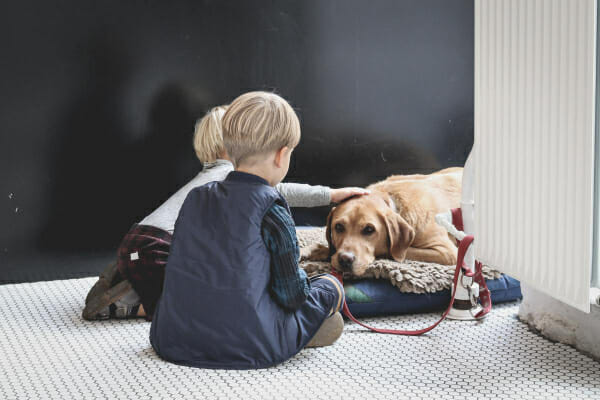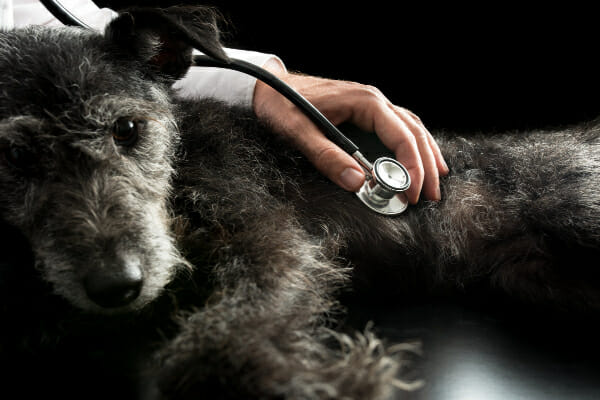Wondering if dog hospice is the right choice for your sweet pup? Integrative veterinarian, Dr. Julie Buzby, invites her friend and pet end-of-life care expert, Dr. Dawnetta Woodruff, to the blog to discuss this difficult but important topic. Over the years, Dr. Woodruff has had the honor of providing hospice care to countless dogs and their families, making her the perfect person to talk about hospice care for dogs.

You may have heard of hospice care for dogs. But how well do you understand it? In simple terms, hospice is a way of caring for our dogs that focuses on palliative care or “comfort care.” A dog’s family may choose hospice care when the vet has diagnosed their dog with a terminal illness. Or perhaps when their pup is in a lot of pain, and the cause of the pain can’t be fixed.
When our young and otherwise healthy dogs get sick, we focus on curing their diseases and extending their lives. But at some point in every dog’s life, our focus shifts from the “diagnose, treat, and cure” mindset, to a “quality-of-life” mindset.
Now the family and the veterinary team are making a conscious choice to prioritize comfort above longevity. For some dogs, this may happen after an aggressive bone cancer diagnosis at the age of four. For other dogs, this may happen at the age of 17 when his or her whole body has grown weak, frail, and painful.
No matter when your dog’s quality of life starts to decline, choosing palliative care may be scary and emotional. It is natural to want our beloved furry family members to be with us as long as possible. However, advanced disease can take away their good moments, and it is difficult to see our loved ones struggling with pain.
Which dogs might need hospice care?

Hospice care can be a good consideration when dogs are dealing with ongoing pain and struggles from disease or conditions such as:
- Advanced canine arthritis or other joint diseases that cause loss of mobility (torn ACL in dogs, hip dysplasia in dogs, etc.)
- Nerve pain secondary to spinal disease such as IVDD in dogs
- Osteosarcoma (bone cancer)
- Transitional cell carcinoma (bladder cancer)
- Hemangiosarcoma in dogs (blood vessel cancer that may cause splenic masses in dogs, liver tumors, or heart tumors)
- Degenerative myelopathy in dogs
- Liver failure
- Kidney failure
- Seizures in dogs
- Brain tumors
- Lymphoma in dogs
- Squamous cell carcinoma (tumors in the mouth or other locations)
- Dementia in dogs (otherwise known as canine cognitive dysfunction, which is similar to Alzheimer’s in people)
Processing your dog’s diagnosis
So what happens when your dog is diagnosed with a terminal condition? You may feel alone, scared, and angry. These feelings are normal, and there are many other dog parents who understand what you are going through. It might be helpful to reach out to an online community for support. You could also consider seeking out local resources (such as counselors and pet loss support groups) to help you during this difficult time.
Also, you can research what to expect as your dog’s disease progresses. The veterinarian who made the diagnosis probably went over this with you, but you may still have questions. It is a good idea to schedule a follow-up exam (or a telehealth visit) with your vet to go over your concerns. Ask your dog’s doctor for a handout about the new diagnosis, or for links to a trusted website. As a word of caution, there is a lot of information on the internet, but it isn’t all reliable. When in doubt, always refer back to your vet.

When might a dog enter hospice care?
Your vet may also recommend a consultation with a specialist such as an oncologist or a cardiologist. Together, your dog’s veterinary team can help you make a decision. Do you want to pursue advanced surgical and medical treatments? Or is it time to consider hospice care?
When a dog’s future includes a lot of pain, struggles, and even suffering, we want to do everything possible to make it better. Sometimes, that means scheduling surgery or pursuing chemotherapy. And sometimes that means allowing him or her to enjoy a few good weeks instead of enduring a few very difficult months.
There is no shame or guilt in choosing hospice. You are not giving up on your dog or choosing for him or her to move closer to death. As much as we would like to, we cannot stop death from happening. We do not have control over when our dog gets a terminal diagnosis. However, we can have a measure of control over the quality of life he or she has in the final days and weeks.
How do I find a hospice veterinarian?
Your regular vet may be able to act as the hospice veterinarian for your dog. Alternatively, you may wish to begin a relationship with a new vet who focuses on hospice and palliative care. The International Association for Animal Hospice and Palliative Care maintains a searchable database of veterinary hospice providers. This can be a great way to find a hospice veterinarian. Also, some hospice vets make house calls, so your dog can stay comfortable and relaxed at home for a veterinary examination.
What does hospice care for dogs look like?
During your dog’s hospice consultation, your vet will do an exam and ask you some questions. This will help him or her figure out if your dog may be dealing with pain or anxiety. Your vet will then make recommendations based on the exam and prescribe medications to control pain, anxiety, nausea, and other symptoms of your dog’s disease.

A hospice veterinarian is able to use a variety of medications (and different doses of common medications) to keep your dog as happy and comfortable as possible. Sometimes, by prioritizing comfort, hospice care can actually help your dog to live not only better but longer!
If the visit happens within your home, your vet will also evaluate your dog’s environment. Then he or she can provide suggestions to make daily life easier. The hospice vet will also discuss your concerns and fears. This can help you prepare the rest of your family (human and animal) for the end of your dog’s life.
Managing a dog’s symptoms at the end of life often means he or she is likely receiving many medications. Pain control often needs to be “multimodal.” This means that you will give several medications that work together in different ways to achieve maximum pain relief. At times, this can be confusing and overwhelming. Each medication has a specific goal for your dog—so if you’re not sure why your dog is taking a certain medication, ask your vet! They will be glad to explain.
Medication considerations
It can be helpful to keep a list of what each medication does, as well as a chart documenting when your dog receives each medication. Mark each dose off after it has been given. This keeps everyone in your household on the same page. It also ensures your dog doesn’t miss a dose of medication or receive the same dose twice!
Some dogs take pills well, and giving comfort medications is relatively easy. But other dogs won’t take pills! You can try wrapping the medication in cheese. Cream cheese and Velveeta cheese work well since they are soft. (As an aside, avoid routinely giving healthy pets these foods due to the risk of pancreatitis in dogs.) Some pills can be crushed and mixed with a bit of yogurt, applesauce, or meat-puree baby foods that do not contain onion or garlic. (But be sure to ask your vet if it is ok to crush your dog’s pills. For some medications, it is important that they stay whole.)
Whether your dog is a good pill taker or a challenge, at some point, many dogs get tired of taking a lot of medications. When this happens, you may wish to have your dog’s medications compounded into a flavored liquid.

Sometimes you get to the point where nothing works and medication time has become stressful. If this is breaking the bond that you have with your beloved canine, it may be time to consider end-of-life care. Sometimes refusing food or medications is your dog’s way of telling you that he or she is tired, and done fighting.
How can you prepare for your dog’s passing?
Quality-of-life is very important but so is quality-of-death. Hospice care allows you to prepare for the “worst case scenario” while making a plan to prevent that scenario from happening. Your goal is to provide your dog with the very best and most peaceful passing he or she can have.
For many families, hospice care will end with euthanasia. They will choose to end their dog’s struggles with the help of medication that allows their dog to pass away in a deep, medicated sleep. However, other families may wish to consider a “natural (unassisted) death.” Your hospice veterinarian will talk through what to expect in each scenario. Then, he or she can help you decide what is best for you and your beloved dog.
Euthanasia
Euthanasia is a word that actually means “good death.” When a veterinarian talks with you about euthanasia, his or her goal is to provide your dog with the least painful, most peaceful way to die. Making the decision to euthanize never feels “good” to our hearts. However, there is comfort and calmness in choosing to help your dog pass away peacefully. You know your dog is no longer struggling, and you were able to be with him or her during the final moments.
If your heart is aching over this decision, you may find solace by reading my additional articles on euthanasia and preparing for your dog’s passing:
- Preparing for Your Dog’s Euthanasia: 10 Thoughts for Peace
- In-Home Dog Euthanasia: Heartfelt Answers to 12 FAQs
- Grieving the Loss of a Dog After Euthanasia (& Finding Peace)
- Dog Euthanasia: Knowing When to Say Goodbye
- How Will You Know When It’s Time to Euthanize Your Dog? 5 Caring, Heartfelt Messages

Natural death
Choosing to let your dog pass away on his or her own is something many people refer to as a “natural death.” But it would be more accurate to call it an “unassisted death.” When you think of a natural death, you may think of a dog peacefully closing his or her eyes and dying a few moments later. However, it often isn’t that fast and smooth.
Yes, there are times that an unassisted death can happen quickly. Unfortunately though, death is more often a long, drawn-out process. When a dog stops eating and drinking, it can take many days before he or she passes away on his or her own. During that time, you may or may not be able to give comfort medications. Many dying dogs are not alert enough to swallow near the end. If giving medication is not possible, your dog may experience varying levels of pain, confusion, and anxiety.
If you have chosen an unassisted death for your dog, it is best to talk with your hospice veterinarian about options to control pain during your dog’s final days of life. It may also benefit you to read Dr. Buzby’s blog that lists some signs your dog is dying so you will know what to expect.
Dog hospice care brings support and peace
Hospice care may sound intimidating, but it shouldn’t be. The goal is to make the end of your dog’s life as full of love and joy as the early years. Hospice care allows you to maintain the precious bond that you have with your dog through the final days. Choosing palliative care for your dog can give you peace of mind. It also means you don’t have to walk through that difficult journey alone. The hospice vet will be there with you, and your dog, every step of the way.

Did you decide to pursue hospice care for your dog?
Please comment below to share your experience.


My dog Deliah (lab/coonhound mix) is 14.5 years old. She was diagnosed with arthritis about 4 or so years ago. Over the last couple of weeks her pain has suddenly increased to where she is randomly yelping through the day and night. We saw the vet and increased her meds to max dose which has made minor improvements. She has been refusing her meds (except a few times) and has not been eating as much as she was. We tried seeing a chiro through the vet and that just made things worse… I have an appointment again on Friday to discuss everything with her vet again and I’m trying to figure out the right questions to ask (ie hospice vs euthanasia). I know her pain is only going to increase as time goes on and I want to make the right choice for her. I just don’t know what it is because she has always been a fighter, even as a puppy when we found her half starved to death, and to see her struggle like this just breaks my heart. Especially when sometimes (more often lately) I don’t see that same fight in her I did just a mere few weeks ago.
Dear Becky,
My heart aches for you as you face this emotional situation with Deliah. I agree it would be good to have your vet to a quality-of-life evaluation and discuss options for how to proceed. It may be that your girl is past the point of comfort care and that saying goodbye would be the most loving option. I will attach links to other articles with mor information and great advice from other readers as well. Hoping you can find the answers you need to make the best choice for your sweet girl. Praying for clarity and peace. Bless you both. ♥
1. Using a Quality of Life Scale for Dogs
2. Amantadine for Dogs: Everything You Need To Know
3. When to Euthanize a Dog With Arthritis: A Vet’s Heartfelt Advice
4. How Will You Know When It’s Time to Euthanize Your Dog? 5 Caring, Heartfelt Messages
5. Preparing for Your Dog’s Euthanasia: 10 Thoughts for Peace
Only 4 days ago, I had to euthanize my 14yo+ Jack Russell, Olive. She had been in kidney failure for almost 3y, but managed to show little change in quarterly bloodwork, remaining moderate, until recently. I returned from a vacation 3 mon ago and since then she seemed to slow down… her labs were still moderate, but getting worse. She still loved walks and parks, but had less energy. It’s been hot, so I got her a cooling vest and that seemed to help some.
Her last Friday, she met me at the door as I returned from work, wagging her whole body as usual. On Sunday, she took frequent breaks on our walk, slower than usual. By Monday, she wagged when asked to go walk-walk but turned back to the house at the end of the driveway. She had NEVER turned down a walk-walk before.
We went to the vet on Tuesday and had labs drawn. Her kidney function was obsolescent. Hospice care was decided to be the most compassionate option and I made an appointment for euthanasia on Monday. Tuesday and Wednesday she was indulged in all of the forbidden proteins and sodium she had been denied for 3y. I gave her anti-nausea/heartburn meds to curb the sumptuous meals. We went to a park on Wednesday and she even got up and stuck her head out of the window on the way.
Thursday morning was different. She turned away from any food and barely had the strength to potty. I called the vet and moved the euthanasia appt from Monday to Friday. I also gave her meds and a bolus of SQ fluids. She felt a little better, so we went to the park and I carried her out to the grass. We sat and enjoyed the morning together.
During that time, I decided that Friday was too far away and 24h was too long for her to endure. We got home at 11am. I called the vet and I said goodbye to her at 11:30.
I recount my experience to emphasize how quickly the disease process can be and the importance of treating every day as if it were the last. I thought I had a good, solid week. I didn’t.
She left with dignity. As we left for the vet, I “hid” a chicken wing in her path. She stood on her own 4 feet and devoured the treasure, bones and all. On the drive over, she didn’t want to hang her head out of the window, like she had the day before. That’s when I knew I had made the right decision. It’s all a blur but I have no regret.
Olive was my best friend for 12+y. She randomly showed up as an energetic, untrained mess a few months after I had experienced a significant loss. She forced me to get up and rejoin life. Together we became certified to visit nursing, schools, etc and even ran races. As much as I mourn her, I am thankful that she is no longer in discomfort.
Thank you for your blog. Writing this has been cathartic and maybe another can find comfort in it, as I had in other’s comments.
Dear Eve,
My heart is broken for you with your loss of Olive. She sounds like an amazing pup…. one that only comes around once in a lifetime. Thank you for being willing to share your story with us. I am certain it will offer comfort to others as they face their own difficult situations. I hope with time your heart will begin to heal and you will be reminded of all the lives Olive touched and changed for the better. May her memory stay with you always and continue to be a blessing in your life. ♥
I am trying to be proactive in planning for an in-home euthanasia for my dog with kidney disease. before we are at the point of making the decision. The one question I have is how involved should our other dog be at the time of the euthanasia?
Dear Cindy,
I am sorry you are facing this difficult decision for your dog. I think it is very wise that you are trying to prepare as best you can and thinking of things from all different angles. I have often had other dogs around when performing a euthanasia and honestly, they really don’t seem to be interested in what is happening. Most will continue playing or napping or whatever they would normally be doing. Some try to come over and check things out but then end up walking away. Others are very interested in me and end up having to be moved to a different room because all they want is for me to play with them and make it difficult to focus on the emotional task at hand. You can truly have things the way it suits your family best. I will attach links to other articles that may be helpful as you prepare to say goodbye. Wishing you all the best and praying for comfort and peace for everyone involved. ♥
1. Preparing for Your Dog’s Euthanasia: 10 Thoughts for Peace
2. In-Home Dog Euthanasia: Heartfelt Answers to 12 FAQs
3. Do Dogs Grieve? Helping Your Dog Cope With Loss
Currently we are dealing with 2 old gentlemen rescued at different times but from similar horrendous situations. Jack is a purebred beagle who came to us with a fused spine, seizures and too many problems to mention but he seemed happy with an incredible will to live, if only to bark at any man within range. Lately all of his problems seem magnified along with low keening sounds at night. He has always been incontinent, requiring frequent diaper changes 24/7. None of our vets can say for sure if he has pain, but I strongly suspect he does. All of this adds up to stressful days and nights for the entire household, which brings me to our 2nd guy, Baxter, approximately 10ish year old beagle, Russell, cocker mix rescue, recently diagnosed with GOLPP. He seems to be rapidly progressing with back end issues and awful laryngeal symptoms. I have (mostly) made peace with what is coming but have learned through many years of experience that hospice care sounds like the best ending for yet another dreaded decision. Both boys have chosen me to be their ‘person’ from day 1 and I believe hospice is the best option to get us through.
Dear Donna,
My heart goes out to you as you prepare to say goodbye to both of your senior pups. I know you did the same for Trooper almost 8 years ago, but it truly never gets any easier. Thank you for sharing your story with our readers. Wishing you comfort and peace as you navigate the difficult path ahead. ♥
Last week we lost Digby, the best most balanced person in our family. He was adopted when he was about 3 or 4 yrs & lived as companion to us & our other working terrier for 11 yrs. Being older, we weren’t surprised when he showed signs of slowing down, napping a bit more, not going out hunting critters or vocalizing with neighbors dogs as much. Across the room one slow TV night we noticed his at rest breathing was more rapid than usual, next night thesame so I took him to his vet the next day, x-ray showed challenged lungs. Infection? ….or worse. Went home with meds for infection, but 4 days on them no improvement, breathing more rapid. Back to vet, next step more comprehensive testing at speciality hospital 2+ hrs away. Took him that evening & left him with some of the most loving, caring Drs & staff I’d ever encountered on a 1st visit. We discussed how they would proceed with the testing and how they would keep him comfortable while waiting for results. Concerned about his breathing, they put him in oxygen ‘tent’ the 1st night, but when they took him out in the a:m. his breathing became labored again, so back to enhanced oxygen where they kept him the next 2 days til dreaded test results came in. He had never indicated at home that he was struggling for breath, only when we counted the breaths per minute as double what it should be were we aware that something wrong. The complete blood panel 3 months before at his geriatric exam looked normal, so we were comfortable that he was generally healthy for his age but cancer in the lungs only shows up in blood tests if it originates in another part of the body 1st & that abnormality can show in bloodwork.
As soon as we heard the diagnosis we knew he would have to be maintained on oxygen just to breath. He was a working terrier who spent most of the time out hunting & digging, a very loving social guy, not happy to lay around doing nothing. Our decision was painfully clear. He was 2 hours away but among people who knew how to love & comfort him as he was eased out of the restrictions his illness had condemned him to. We loved him enough to set him free, but ooooh! that hurts so much.
Hi Ani,
So sorry for the loss of your beloved Digby. It sounds like you absolutely made the most loving and compassionate decision you could by choosing to let him go. That loss is always so painful though, no matter how much you know it is the right thing to do. It sounds like Digby had a wonderful life with you, full of love, hunting, and digging—all things that make terriers extremely happy! May the wonderful memories you shared together give you some measure of comfort (and perhaps a smile or laugh) you grieve this loss. ❤